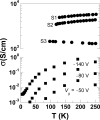Beyond the metal-insulator transition in polymer electrolyte gated polymer field-effect transistors
- PMID: 16873547
- PMCID: PMC1567663
- DOI: 10.1073/pnas.0605033103
Beyond the metal-insulator transition in polymer electrolyte gated polymer field-effect transistors
Abstract
We have studied the carrier transport in poly(2,5-bis(3-tetradecylthiophen-2-yl)thieno[3,2-b]thiophene) field-effect transistors (FETs) at very high field-induced carrier densities (10(15) cm(-2)) using a polymer electrolyte as gate and gate dielectric. At room temperature, we find high current densities, 2 x 10(6) A/cm(2), and high metallic conductivities, 10(4) S/cm, in the FET channel; at 4.2 K, the current density is sustained at 10(7) A/cm(2). Thus, metallic conductivity persists to low temperatures. The carrier mobility in these devices is approximately 3.5 cm(2).V(-1).s(-1) at 297 K, comparable with that found in fully crystalline organic devices.
Conflict of interest statement
Conflict of interest statement: No conflicts declared.
Figures



References
-
- Chiang C. K., Fincher C. R., Park Y. W., Heeger A. J., Shirakawa H., Louis E. J., Gau S. C., Macdiarmid A. G. Phys. Rev. Lett. 1977;39:1098–1101.
-
- Lee K., Cho S., Heum Park S., Heeger A. J., Lee C.-W., Lee S.-H. Nature. 2006;441:65–68. - PubMed
-
- Tal O., Rosenwaks Y., Preezant Y., Tessler N., Chan C. K., Kahn A. Phys. Rev. Lett. 2005;95:256405. - PubMed
-
- Dhoot A. S., Wang G. M., Moses D., Heeger A. J. , Phys. Rev. Lett. 2006;96:246403. - PubMed
-
- Bardeen J., Brattain W. H. Phys. Rev. 1948;74:230–231.
Publication types
MeSH terms
Substances
LinkOut - more resources
Full Text Sources
Other Literature Sources
Miscellaneous

